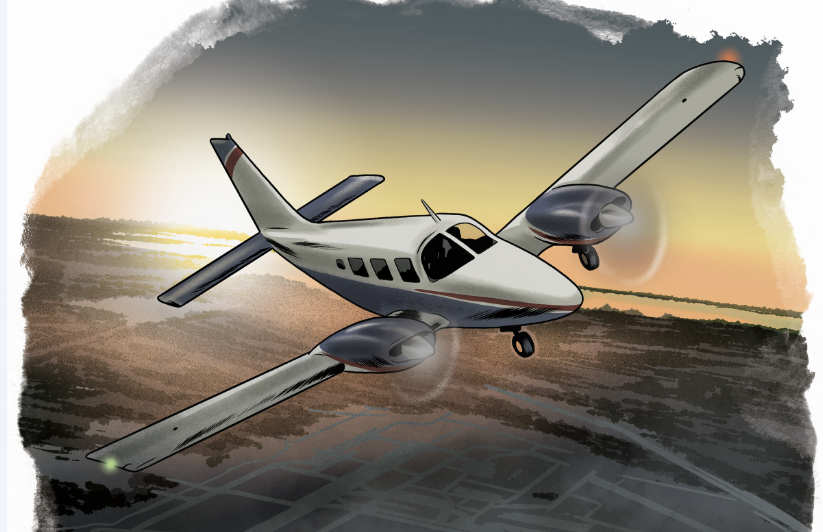Bending metal was not something I planned on. I thought my thousands of hours as a flight instructor and commuter pilot had given me sufficient skill, proficiency, and experience to avoid damaging an aircraft. The events of May 8, 1998, taught me otherwise.
I had leased our 1977 Piper Seneca II through a Part 135 charter program for several years and flown my family all over the U.S. before deciding that the aircraft had become too costly to maintain. After agreeing to sell, I flew the aircraft from Lawrence, Massachusetts (KLWM), to Kenosha, Wisconsin (KENW), for a prepurchase inspection. The prospective buyer’s favorite A&P mechanic turned up minor issues as well as a few airworthiness items.
In addition to a small oil leak, the mechanic reported worn gear door hinges and a faulty left tachometer. Being conscientious, I hired the A&P to repair the airworthiness items, and I returned home. This was my first mistake—never lose possession of your airplane during a prepurchase inspection.
The prospective sale fell through, forcing me to return to Wisconsin to retrieve the airplane. The A&P reported the gear had been jacked and swung, and the aircraft had been test flown the day before. I trusted this fellow. This was my second mistake. I did not have clear evidence of testing.
While I was preflighting the aircraft, he crawled under the wing and used wire cutters in the left door hinge area. When I asked what he was doing, he answered, “Just making sure everything is correct.” My third mistake—I did not challenge him directly on his actions, figuring the mechanic always knows best.
I updated my IFR flight plan and rechecked the weather. I would stop in Syracuse, New York (KSYR), to refuel and review the en route weather, which had the potential to turn ugly as a result of a strong cold front approaching.
Low ceilings, rain showers, and light turbulence accompanied me during my three-hour flight. At 3,500 feet, I broke through the overcast and descended on vectors to an ILS approach to Runway 28 at Syracuse Hancock International Airport. The airport waited, surrounded by the region’s numerous lakes and the gloom of the approaching front.
I extended a notch of flaps at the outer marker on the ILS and dropped the gear at 110 knots to slow the aircraft and stay on the glide slope. The red gear unsafe light stayed illuminated, and the right main gear down green light failed to illuminate. The gear did not sound right, so I slowed further and cycled the gear up and down, checking the circuit breaker. Via the cowl mirror I observed the nose gear retracting and extending normally, but the red gear unsafe light stayed on, and the right main gear down green light stayed dark. I notified the tower of my situation and obtained an altitude and heading away from the approach course out over Oneida Lake.
Circling, I worked through the expanded AFM emergency checklist and performed a manual extension at 85 knots. The unsafe light conditions persisted, and I still could not hear or feel evidence of the right main gear extension.
As the sky darkened on the western horizon, I walked the rudders and changed the green gear down lightbulbs. The controller verified the line of level 2 and level 4 cells rapidly approaching from the west. The weather would not permit orbiting VFR to burn the 1.5 hours of remaining fuel before landing.
Finding another airport at which to land, given the weather and obvious need for crash rescue trucks, was not prudent. I had to land. I declared an emergency and requested the equipment, certain that the right main gear was out of its uplocks but not down.
On short final, the tower issued a wind shear perimeter alert for the airport’s west side, leaving me with one option. I needed to land the airplane on the left main gear and shut down the engines on rollout. With adrenaline surging, my touchdown on Runway 28 coincided with a burst of strong and gusty quartering headwinds.
As the lead crash truck followed me, I used the wind to hold up the right wing by varying aileron input. Retarding the throttles, I moved the mixture controls to idle cutoff and feathered the props quickly. As the airplane rocked and slowed in the wind gusts, I shut off the mags and master and closed both fuel valves. The screech of bending and crunching metal filled the cabin when the wing met the runway.
Seconds later, I set the rest of the switches to the off position and exited the aircraft, embracing the violent wind and cold rain. I watched my aircraft being jacked and towed to a maintenance facility, where the FAA would later inspect it.
The inspection revealed that the A&P had installed the gear door hinges in the backward position. The wire on the right door hinge had prevented the gear from moving down after leaving the uplocks. Coincidentally, the left gear hinge was improperly installed and appeared to have been cut, allowing extension by force.
Was this the adjustment the mechanic made during my preflight? I have no definitive proof. I will always fly my own test flights or watch a pilot from the mechanic’s shop perform the flight.
The FAA inspector reassured me that I had handled the situation correctly. The prepurchase mechanic was cited by the FAA and sent for remedial training. Since the damage amounted to a $5,000 aileron and wing step repair, it was classified as an incident, not an accident.
First, I should not have trusted the mechanic without question. Second, I should have flown my own test flight in VFR conditions and not on an IFR cross-country into the weather. Most importantly, I learned that in aviation there are people you can trust and those you cannot.
This column first appeared in the January-February 2024/Issue 945 of FLYING’s print edition.
